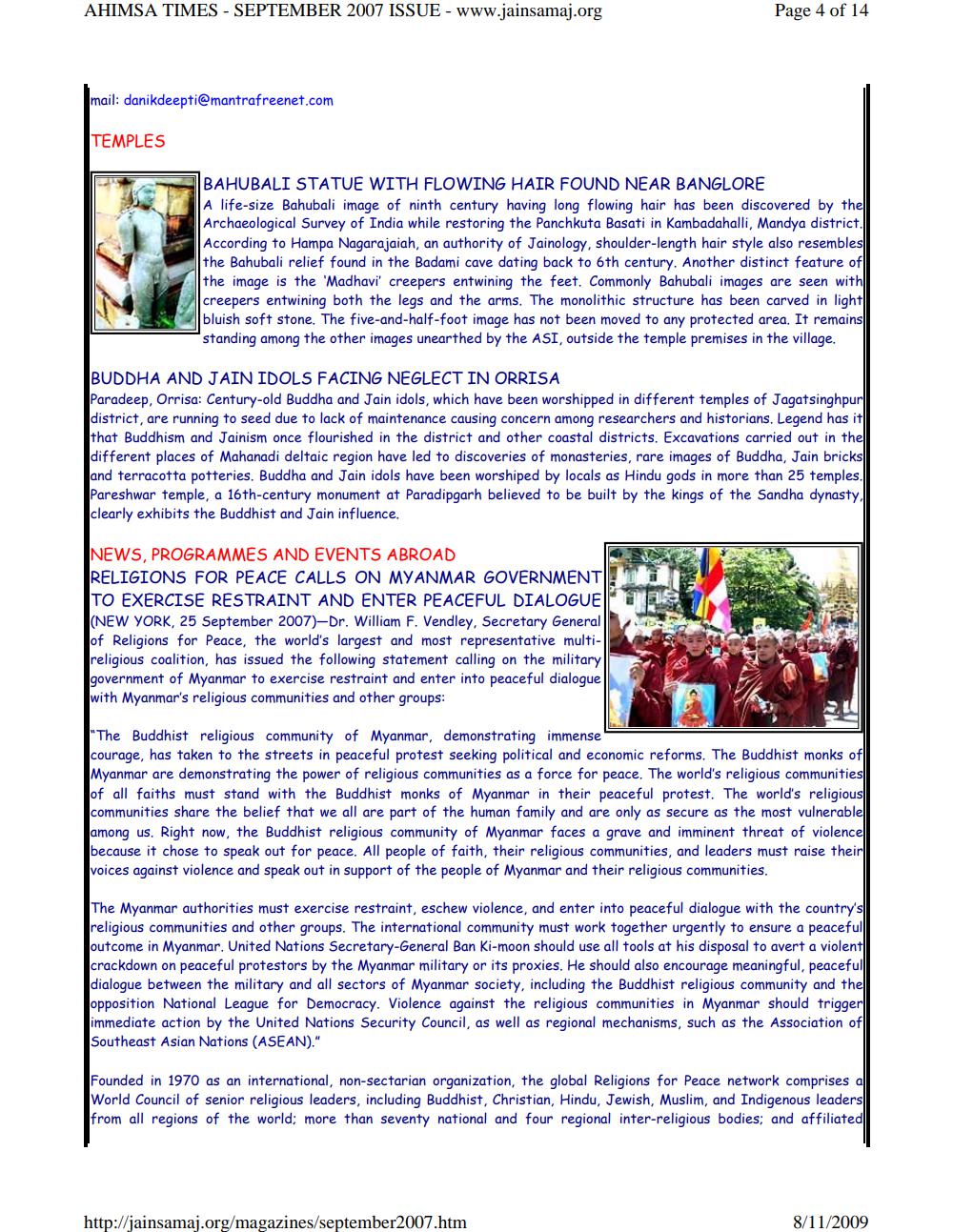Book Title: Ahimsa Times 2007 09 SrNo 87 Author(s): Ahimsa Times Publisher: Ahimsa Times View full book textPage 4
________________ AHIMSA TIMES - SEPTEMBER 2007 ISSUE - www.jainsamaj.org mail: danikdeepti@mantrafreenet.com TEMPLES BAHUBALI STATUE WITH FLOWING HAIR FOUND NEAR BANGLORE A life-size Bahubali image of ninth century having long flowing hair has been discovered by the Archaeological Survey of India while restoring the Panchkuta Basati in Kambadahalli, Mandya district. According to Hampa Nagarajaiah, an authority of Jainology, shoulder-length hair style also resembles the Bahubali relief found in the Badami cave dating back to 6th century. Another distinct feature of the image is the 'Madhavi' creepers entwining the feet. Commonly Bahubali images are seen with creepers entwining both the legs and the arms. The monolithic structure has been carved in light bluish soft stone. The five-and-half-foot image has not been moved to any protected area. It remains standing among the other images unearthed by the ASI, outside the temple premises in the village. Page 4 of 14 BUDDHA AND JAIN IDOLS FACING NEGLECT IN ORRISA Paradeep, Orrisa: Century-old Buddha and Jain idols, which have been worshipped in different temples of Jagatsinghpur district, are running to seed due to lack of maintenance causing concern among researchers and historians. Legend has it that Buddhism and Jainism once flourished in the district and other coastal districts. Excavations carried out in the different places of Mahanadi deltaic region have led to discoveries of monasteries, rare images of Buddha, Jain bricks and terracotta potteries. Buddha and Jain idols have been worshiped by locals as Hindu gods in more than 25 temples. Pareshwar temple, a 16th-century monument at Paradipgarh believed to be built by the kings of the Sandha dynasty. clearly exhibits the Buddhist and Jain influence. NEWS, PROGRAMMES AND EVENTS ABROAD RELIGIONS FOR PEACE CALLS ON MYANMAR GOVERNMENT TO EXERCISE RESTRAINT AND ENTER PEACEFUL DIALOGUE (NEW YORK, 25 September 2007)-Dr. William F. Vendley, Secretary General of Religions for Peace, the world's largest and most representative multireligious coalition, has issued the following statement calling on the military government of Myanmar to exercise restraint and enter into peaceful dialogue with Myanmar's religious communities and other groups: "The Buddhist religious community of Myanmar, demonstrating immense courage, has taken to the streets in peaceful protest seeking political and economic reforms. The Buddhist monks of Myanmar are demonstrating the power of religious communities as a force for peace. The world's religious communities of all faiths must stand with the Buddhist monks of Myanmar in their peaceful protest. The world's religious communities share the belief that we all are part of the human family and are only as secure as the most vulnerable among us. Right now, the Buddhist religious community of Myanmar faces a grave and imminent threat of violence because it chose to speak out for peace. All people of faith, their religious communities, and leaders must raise their voices against violence and speak out in support of the people of Myanmar and their religious communities. The Myanmar authorities must exercise restraint, eschew violence, and enter into peaceful dialogue with the country's religious communities and other groups. The international community must work together urgently to ensure a peaceful outcome in Myanmar. United Nations Secretary-General Ban Ki-moon should use all tools at his disposal to avert a violent crackdown on peaceful protestors by the Myanmar military or its proxies. He should also encourage meaningful, peaceful dialogue between the military and all sectors of Myanmar society, including the Buddhist religious community and the opposition National League for Democracy. Violence against the religious communities in Myanmar should trigger immediate action by the United Nations Security Council, as well as regional mechanisms, such as the Association of Southeast Asian Nations (ASEAN)." Founded in 1970 as an international, non-sectarian organization, the global Religions for Peace network comprises a World Council of senior religious leaders, including Buddhist, Christian, Hindu, Jewish, Muslim, and Indigenous leaders from all regions of the world; more than seventy national and four regional inter-religious bodies; and affiliated http://jainsamaj.org/magazines/september2007.htm 8/11/2009Page Navigation
1 2 3 4 5 6 7 8 9 10 11 12 13 14
